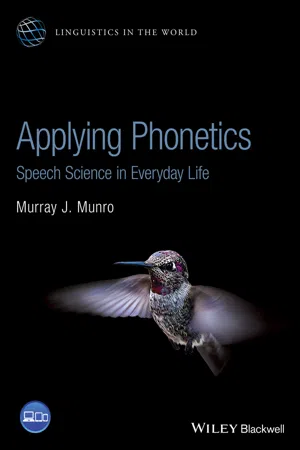
- English
- ePUB (mobile friendly)
- Available on iOS & Android
About this book
A unique and accessible introduction to the field of phonetics through real-life applications and practical examples
The dynamic field of phonetics, the science of the structure and function of human speech, has seen exciting technological innovations and new applications in recent years. Applying Phonetics introduces students to the field through a unique exploratory approach that highlights practical applications and focuses on the diverse ways in which the speech sciences influence daily life. Requiring no prior knowledge of linguistics, this accessible, student-friendly textbook introduces the key concepts in phonetics and explains their relevance to contemporary applications. Even students who have completed introductory linguistics courses will discover plenty of new material in this volume.
Rather than immediately delving into complex theoretical information, the text presents a brief overview of basic concepts and then uses applications—speech synthesis, forensic speech science, language teaching—to explain the details. This unique approach increases student interest and comprehension, clearly demonstrating how speech science is beneficial to society. Engaging, easily-relatable topics include speech anatomy and physiology, the nature of normal and disordered speech development, the origins of speech, and speech applications in forensics, music, drama, film, and business. Written by a respected expert with over 25 years' experience teaching linguistics and phonetics, this textbook
- Explores the wide-ranging applications of phonetics areas such as accessibility, computer speech, education, the fine arts, and business
- Demonstrates how practical problems have been addressed through phonetics, such as the use of speech analysis for forensic purposes
- Presents real-life case studies that illustrate fundamental phonetics concepts
- Includes exercises and activities, discussion questions, an extensive glossary, further readings, and a companion website
Applying Phonetics: Speech Science in Everyday Life is an ideal text for undergraduate students with no prior knowledge of linguistics, as well as those needing to expand their knowledge of phonetic principles. It will appeal to students in education, computer science, cognitive science, biology, psychology, business, and music.
Frequently asked questions
- Essential is ideal for learners and professionals who enjoy exploring a wide range of subjects. Access the Essential Library with 800,000+ trusted titles and best-sellers across business, personal growth, and the humanities. Includes unlimited reading time and Standard Read Aloud voice.
- Complete: Perfect for advanced learners and researchers needing full, unrestricted access. Unlock 1.4M+ books across hundreds of subjects, including academic and specialized titles. The Complete Plan also includes advanced features like Premium Read Aloud and Research Assistant.
Please note we cannot support devices running on iOS 13 and Android 7 or earlier. Learn more about using the app.
Information
Part I
What Is Speech?
1
Introducing Phonetics : The Science of Speech

1.1 speech, language, and communication
1.1.1 classifying communication types
Table of contents
- Cover
- Table of Contents
- Title Page
- Copyright Page
- Foreword
- Acknowledgments
- About the Companion Website
- Part I: What Is Speech?
- Part II: Speech as a Human Phenomenon
- Part III: Applying Phonetics
- Epilogue
- Appendix North American English Consonants
- Glossary
- List of Sources
- Index
- End User License Agreement